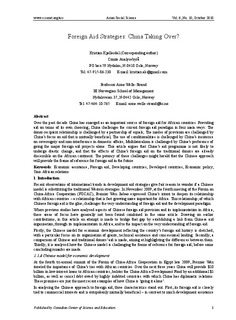| dc.contributor.author | Welle-Strand, Anne | |
| dc.contributor.author | Kjøllesdal, Kristian | |
| dc.date.accessioned | 2010-10-05T08:09:09Z | |
| dc.date.available | 2010-10-05T08:09:09Z | |
| dc.date.issued | 2010 | |
| dc.identifier.citation | Asian Social Science, Vol. 6, No. 10 (2010), p. 3-13. | en_US |
| dc.identifier.issn | 1911-2025 | |
| dc.identifier.uri | http://hdl.handle.net/11250/93344 | |
| dc.description | Til utgivers side (Åpen tilgang/Open Access): http://www.ccsenet.org/journal/index.php/ass/article/view/6491 | en_US |
| dc.description.abstract | Over the past decade China has emerged as an important source of foreign aid for African countries. Providing
aid on terms of its own choosing, China challenges the current foreign aid paradigm in four main ways: The
donor-recipient relationship is challenged by a partnership of equals; The modes of provision are challenged by
China’s focus on aid that is mutually beneficial; The use of conditionalities is challenged by China’s insistence
on sovereignty and non-interference in domestic affairs; Multilateralism is challenged by China’s preference of
going the major foreign aid projects alone. This article argues that China’s aid programme is not likely to
undergo drastic change, and that the effects of China’s foreign aid on the traditional donors are already
discernible on the African continent. The potency of these challenges might herald that the Chinese approach
will provide the frame of reference for foreign aid in the future. | en_US |
| dc.language.iso | eng | en_US |
| dc.publisher | Canadian Center of Science and Education | en_US |
| dc.title | Foreign aid strategies: China taking over? | en_US |
| dc.type | Journal article | en_US |
| dc.type | Peer reviewed | en_US |
| dc.source.pagenumber | 3-13 | en_US |
